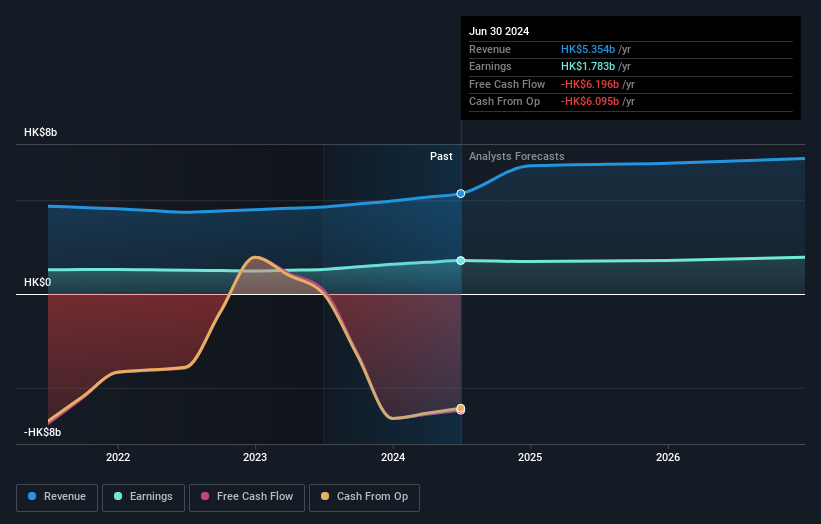
Key Insights
- Insiders appear to have a vested interest in Dah Sing Financial Holdings' growth, as seen by their sizeable ownership
- A total of 3 investors have a majority stake in the company with 55% ownership
- Insiders have been selling lately
Every investor in Dah Sing Financial Holdings Limited (HKG:440) should be aware of the most powerful shareholder groups. The group holding the most number of shares in the company, around 41% to be precise, is individual insiders. In other words, the group stands to gain the most (or lose the most) from their investment into the company.
Insiders are at the top of the company's shareholdings despite selling some shares recently. As a result, they were also the biggest winners as market cap hit HK$9.9b last week.
In the chart below, we zoom in on the different ownership groups of Dah Sing Financial Holdings.
Check out our latest analysis for Dah Sing Financial Holdings

What Does The Institutional Ownership Tell Us About Dah Sing Financial Holdings?
Many institutions measure their performance against an index that approximates the local market. So they usually pay more attention to companies that are included in major indices.
We can see that Dah Sing Financial Holdings does have institutional investors; and they hold a good portion of the company's stock. This suggests some credibility amongst professional investors. But we can't rely on that fact alone since institutions make bad investments sometimes, just like everyone does. When multiple institutions own a stock, there's always a risk that they are in a 'crowded trade'. When such a trade goes wrong, multiple parties may compete to sell stock fast. This risk is higher in a company without a history of growth. You can see Dah Sing Financial Holdings' historic earnings and revenue below, but keep in mind there's always more to the story.

Dah Sing Financial Holdings is not owned by hedge funds. From our data, we infer that the largest shareholder is Shou-Yeh Wong (who also holds the title of Top Key Executive) with 39% of shares outstanding. Its usually considered a good sign when insiders own a significant number of shares in the company, and in this case, we're glad to see a company insider play the role of a key stakeholder. Meanwhile, the second and third largest shareholders, hold 10.0% and 5.6%, of the shares outstanding, respectively.
After doing some more digging, we found that the top 3 shareholders collectively control more than half of the company's shares, implying that they have considerable power to influence the company's decisions.
While studying institutional ownership for a company can add value to your research, it is also a good practice to research analyst recommendations to get a deeper understand of a stock's expected performance. There is some analyst coverage of the stock, but it could still become more well known, with time.
Insider Ownership Of Dah Sing Financial Holdings
The definition of an insider can differ slightly between different countries, but members of the board of directors always count. Company management run the business, but the CEO will answer to the board, even if he or she is a member of it.
Insider ownership is positive when it signals leadership are thinking like the true owners of the company. However, high insider ownership can also give immense power to a small group within the company. This can be negative in some circumstances.
Our information suggests that insiders maintain a significant holding in Dah Sing Financial Holdings Limited. It is very interesting to see that insiders have a meaningful HK$4.0b stake in this HK$9.9b business. Most would be pleased to see the board is investing alongside them. You may wish to access this free chart showing recent trading by insiders.
General Public Ownership
With a 36% ownership, the general public, mostly comprising of individual investors, have some degree of sway over Dah Sing Financial Holdings. While this group can't necessarily call the shots, it can certainly have a real influence on how the company is run.
Next Steps:
It's always worth thinking about the different groups who own shares in a company. But to understand Dah Sing Financial Holdings better, we need to consider many other factors. Take risks for example - Dah Sing Financial Holdings has 2 warning signs we think you should be aware of.
But ultimately it is the future, not the past, that will determine how well the owners of this business will do. Therefore we think it advisable to take a look at this free report showing whether analysts are predicting a brighter future.
NB: Figures in this article are calculated using data from the last twelve months, which refer to the 12-month period ending on the last date of the month the financial statement is dated. This may not be consistent with full year annual report figures.
Have feedback on this article? Concerned about the content? Get in touch with us directly. Alternatively, email editorial-team (at) simplywallst.com.
This article by Simply Wall St is general in nature. We provide commentary based on historical data and analyst forecasts only using an unbiased methodology and our articles are not intended to be financial advice. It does not constitute a recommendation to buy or sell any stock, and does not take account of your objectives, or your financial situation. We aim to bring you long-term focused analysis driven by fundamental data. Note that our analysis may not factor in the latest price-sensitive company announcements or qualitative material. Simply Wall St has no position in any stocks mentioned.